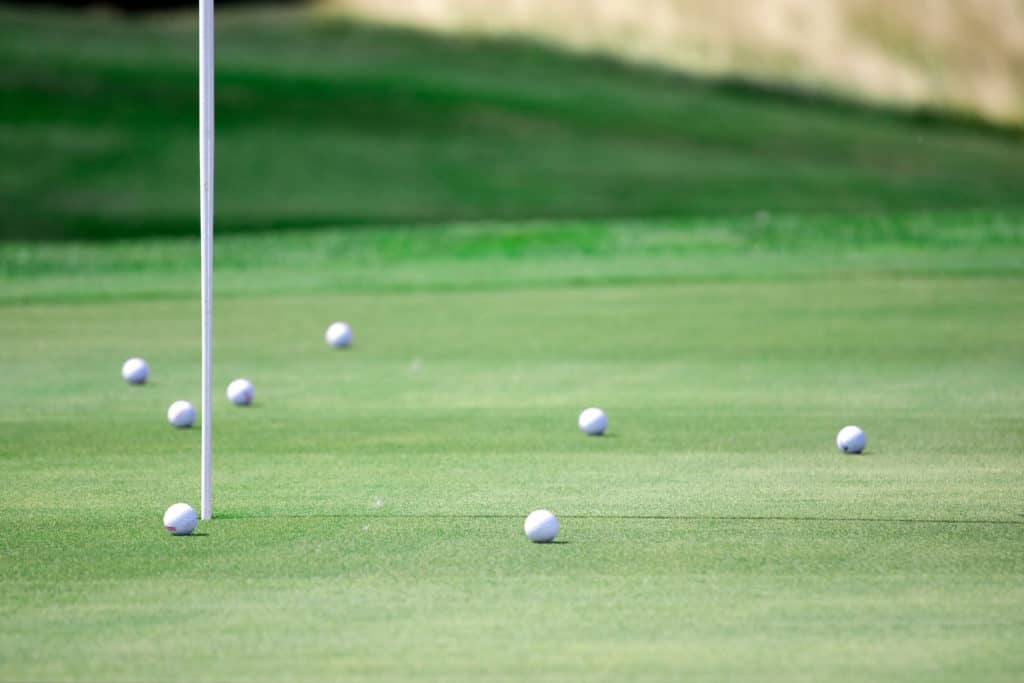11 Keys to Prepare for a golf tournament:
- Stop chasing swing changes at least a week out
- Put in enough work to feel prepared
- Spend time around the practice green
- Be strategic at the practice range
- Play the course several times
- Take detailed notes on the course
- Shift to a target based approach
- Put yourself in other pressure situations
- Relax the evening before
- Stick to your routine the morning of
- Separate who are as a person from your results
Many golfers love to compete!
Whether someone is a highly competitive junior golfer or someone who simply wants to play their best round of golf at a big event coming up, the key is in the preparation.
People all across the world play in different varieties of golf tournaments.
There are golfers that play in the annual club championship at their local golf course or playing on a tour that host different events throughout the year.
Getting ourselves in a position both physically and mentally to play our best golf is a major key in how we prepare for the upcoming golf tournament.
We have found, through our own experience and talking with many high level performers to go through a process in our preparation leading up to a big golf tournament.

How To Prepare For A Golf Tournament: Top 11 Tips
Update: This past summer I found #11 to be vitally improtant. Also, I created my own identity that I was a mentally tough golfer and that I would find my swing and get in a groove at some point during the round. Self identity and how you think of yourself is so improtant. If you start beating yourself up over a slow start, you are going to struggle! Be tough, be resilient and have fun! See the challenge as fun and something you are looking forward to getting better at!
Let’s dive further into the top 11 tips to make sure you can experience success when you hit the course for your tournament round of golf.
Tip #1: Stop chasing swing changes at least a week out
Many competitive golfers love to tinker with their swing. They think if they make one little change it is going to be the secret to their consistency. They can head to the golf course free of some major swing thoughts and enjoy the round.
Half of the battle during a round of golf is having confidence in your swing. Stick the basics in the weeks leading up to your tournament. FOcus on things like your grip, alignment, stance and carry distance for each club. Even if you are struggling with your swing, resist the urge to make major swing changes anything inside a week of the tournament.
Instead, stick with your routine, check the basics if you are struggling and let go of the tension that may be a result from the tournament getting closer on the calendar. Stick to your pre shot routine and keep working on the different shots required for the course that you will play. Tension can be the ultimate swing destroyer. Try to find your method for relaxing and allowing your natural instincts to take over.
If you have a swing coach, maybe see your swing coach 1-2 weeks out for some fine tuning.
Tip #2: Put in enough work to feel prepared
When a golfer has confidence that they have worked hard and are prepared for the tournament, chances are they will play better than the person that feels under prepared. This means paying attention to every facet of the game. The driver, fairway woods, long irons, approach shots, wedge, chipping and putting. Also, make sure you establish and stick with a pre shot routine that allows you to settle in before every shot.
I would highly recommend your own portable launch monitor to help you dial in the distances that are hitting each club. Creating a chart of your expected carry distance is a key to your success and being able to control your approach shots into the green. A chart that looks like the one below could be helpful:
| Club | Carry Distance (100%) | 90% | 80% |
| 4 iron | 190 | ||
| 5 iron | 181 | ||
| 6 iron | 171 | ||
| 7 iron | 163 | ||
| 8 iron | 153 | ||
| 9 iron | 143 | ||
| P Club | 130 | ||
| PW Club | 118 | 110 | 102 |
| SW Club | 105 | 97 | 91 |
| LW Club | 90 | 82 | 74 |
I would highly recommend checking out one of the three linked launch monitors below. These devices can help you measure your distances and help you dial in what club you need to hit on every approach shot.
Here are the top 3 options to check out:
If you visit any local PGA Tour event you will see close to 100% of the players working with a launch monitor at some point. While you may not be able to afford a Trackman, you might be able to go with one of the three options above and have some significant data to help improve your game or measure key data as your prepare for a tournament:
- Carry Distance and Total Distance
- Ball Speed
- Spin Rate
- Spin Axis
- Launch Angle
The difference between a 110 yard wedge and a 115 yard wedge could mean a birdied vs a bogey. Sometimes the best struck shots are penalized because you lack the information you need to be prepared! I went with the SkyTrak and have thrilled with the versatility to use at the practice range or as part of my home golf simulator setup. See the links below for more information on the SkyTrak and building your own golf simulator space!
Resource: SkyTrak Launch Monitor: The ultimate game improvement tool!
Tip #3: Spend time around the practice green
Most golfers when faced with an event where they really want to play well might struggle early in a round until they settle in and start to relax. This is where the short game becomes very important to their overall success. YOu might be forced to save par early in the round and chipping the ball to 3 feet or closer is one way to help you relax. You tap the ball in for par and head to the next tee.
Building the feels for your short game chipping, pitching and putting will help you gain confidence and save you some significant shots over the round of golf. Often those that putt the best and can save par when a green is missed end up with the best scores. The formula is pretty simple! Keep the ball in play, keep in around the green and make sure your short game is sharp!
I would recommend assessing your short game by utilizing the following drill in your practice time:
- Throw a ball around the practice green to a random spot.
- Pick a pin on the green to chip the ball towards.
- See if you can chip the ball and get down in one putt.
- Write down on many times out 10 you are successful.
- Repeat this drill at least 1-2 times per day in the 7 days leading up to the tournament.
Resource: 22 practice games

Tip #4: Be strategic at the practice range
While block practice at the practice range can be helpful for certain parts of the golf swing, hitting too many 7 irons, drivers, or whatever club in a row can end up getting boring as your trying to hit the perfect shot over and over again.
If you know the course you are playing check out this routine instead:
- Picture the tee shot on the first hole.
- Determine the edges of the fairway or hole to simulate the shot.
- Go ahead and hit the shot using the right club.
- Assess and estimate what distance you might have left.
- For example, if it is a 400 yard hole and you hit your driver around 250, you have 150 left.
- Hit your 150 club to a target on the practice range.
- Repeat this process for all 18 holes.
- Play this game every day for 7 days leading up to the tournament.
When you face those shots on the course, you can have confidence that you have hit the shot before and are able to execute. Figure out if a draw or fade is the go to shot as you practice at the range. For those shots that you struggle with, go back and re hit the shot at the end to build the confidence.
Resource: Driving Range Tips
Tip #5: Play the course several times
If you are within a reasonable driving distance to the course you will be playing for a tournament, make sure you get there at least one time prior to the tournament. Hit the different shots that you are faced with and really try to learn the greens that you will be playing. From watching the touring pros prepare for a tournament, they spend the majority of their time around the greens, hitting chips and putts to the potential pin placements.
Many golfers will now check out the google earth images of the course you are playing and take some measurements, noting hazard distance and unexpected areas.
Tip #6: Take detailed notes
Make sure you have a notebook and a scorecard to detail your notes of what club you hit from certain distances and where the pins might be. Also, write down the general direction that greens break and the speed of the day you played. This will give you a reference point when putting on the greens come tournament day!
Take note of distances to certain hazards, carry distances on the bunkers and other key information to help you keep the ball in play.
I would highly recommend taking a rangefinder with you to your practice round to help you map out the course while you take your detailed notes.
Resource: What do golfers write in their notebooks (7 Items)
Recommended RangeFinder:
Tip #7: Shift to a target based approach
To help relieve the pressure of chasing mechanics, start playing golf in a target based approach. Pick your target, your flight plan and hit the shot. If you struggle to hit certain shots, try to replicate those shots on the practice range that evening.
However, try to stick with tip 1 and not make some major swing changes. Instead look at your grip, alignment, etc and make minor tweaks if needed. Oftentimes, the best golfers will hit poor shots from a lack of a plan or confidence as they stand over the golf ball.
If you need some tips on this approach, check out Shawn Clement and our review of his approach!
Tip #8: Put yourself in other pressure situations
Find ways to compete in the weeks leading up to the tournament. The key is to find some pressure situations and see how you respond. Many golfers like to put something as small as a couple of dollars on the line in a friendly match. The PGA Tour pro stories that come out have them playing for some decent money in the days prior to the tournament. The best competitors look forward to this pressure and seek it out as much as possible to help build the confidence that they can respond under pressure.
I would recommend looking for a least one pressure situation somewhere inside of the 7 days leading up to the tournament.
The short game drill listed above is another individual pressure situation you can create on your own. Test yourself throughout the week and build up the resilience it will take to play quality golf and execute under the pressure.
Tip #9: Relax the evening before
If you handle your preparation in the right manner, you shouldn’t be scrambling the evening before to fix your swing or to get ready for the tournament. While you will want to play or hit golf balls, don’t overdue to the point where you are building pressure and trying to play catch up. Instead, get your work in and then go do something fun. Free your mind and enjoy the evening so you can head to the course relaxed and ready to go!
Tip #10: Stick to your routine the morning of
I would recommend arriving at the course an hour and 15 minutes ahead of time. This will give you time to check in and about 1 hour to get ready. Build this routine prior to arriving that day and stick with it. Make sure you spend time at the practice range so you can warm up and stretch out and then head to the practice green to build confidence by making some 3-10 footers and testing the speed of the greens on those longer lag putts.
Find what works best for you in the weeks leading up as far as how to best manage a one hour warm up! You might go through the hole by hole routine that was described above at the range that day.

Tip #11: Separate who are as a person from your results
The key is to know that who you are as a person is not defined by your results at a tournament. The bottom line is that there aren’t too many people who care what you actually score that day. Be a good person wherever you go and do the right thing.
What you score on a golf course does not reflect or define who you are! Enjoy the round of the golf and the challenge to play your best. Be your biggest cheerleader and give yourself pep talks by being encouraging and lifting yourself up. When times get rough during the round, stay positive and remember that golf is supposed to be fun!
BONUS TIP: Properly pack your golf bag
One other quick tip for your golf bag to ensure you are all set and not scrambling the morning of your golf tournament. Make sure you have enough golf balls, golf tees, rain gear, umbrella and an extra golf gloves. Be prepared for the weather and potential conditions that might make your round more challenging. Being ready for any conditions will help you handle those situations with ease.
Check out Zen Golf on amazon for a great book on the mental side of golf!
Final Thoughts: How To Prepare For A Golf Tournament
Remember to have fun in your preparation and the day of the tournament. Control your response to every event that happens on the course with intention and keeping your mindset right. Expect to have some things not go your way. The ball might be a bad kick or you might end up in a divot in the firway.
These are both expected events during a round of golf. How you respond to these events will define and impact the score that you post that day! Stay calm, have fun and enjoy the journey!
Take Action – What You Can Do Today to Get Better
What does this mean for you? I believe in the following recipe to get better:
1 – Improve your motion in the golf swing by identifying a golf instructor. Here are some options:
Here is a list of golf instructors that we have reviewed:
2 – Train to swing faster and improve your swing speed. Here are some options:
Looking to gain more Speed and Distance in your swing. Two Options:
3 – Understand course strategy and work to break through your next barrier. Here is a series on breaking through:
We have provided guides on how to break 100, 90, 80 and 70. Check out more below, if interested.
4 – Practice Frequently
Did you know that I build a golf simulator in my garage and have played over 500 rounds of golf on my SkyTrak system? It has been a game changer and one worth checking out. Here are some of my other posts on golf simulators frequently asked questions:
- Is a Golf Simulator Worth It?
- How to Build a Golf Simulator?
- What is the Best Golf Simulator?
- Golf Simulator Accessories?
- How to Build a Golf Simulator for under $7000
- Top 11 Reasons to Buy a SkyTrak
- How to Build a Golf Simulator for Under $1000
- Why Build A Golf Simulator?
- What Space is Needed?
- Can A Golf Simulator Improve My Game?
- How Much Does A Golf Simulator Cost?
- Don’t Forget to Check out our 15 best golf swings of all time.
I am an amateur golfer on a journey to get better, enjoy the game as often as possible and share my passion and knowledge with others. I have coached high school golfers at a high level and have a great passion for the game and want to give back. I enjoy learning about the golf swing and am currently studying to be a certified professional golf instructor. Join me in our journey to get better everyday. Thank you for reading!

